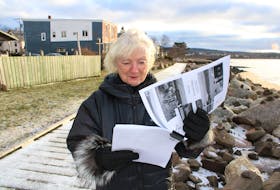The Groundhog Day storm blew through the Bay of Fundy 35 years ago this week and into the history books. It was the storm of the century. Before the storm blew itself out, it had redrawn the coastal map, brought devastation to fishing communities from Baccaro to Westport, reduced fishermen’s wharfs and farmers’ barns to sticks and forced everyone to confront the realities of a world without electricity. The damage sustained by the storm’s relentless assault has etched itself into our collective memory.
When then Yarmouth MLA Hugh Tinkham left for work that morning, the 8 a.m. radio was forecasting warm temperatures and 30 mph winds. Throughout the morning, as he worked in his office, he was oblivious to the disaster that was unfolding.
“What’s 30 mph winds? Around here? That’s just a winter day,” he recalled.
It wasn’t until the power went out and he left the office for his Milton Highlands home that he realized something was wrong. In the parking lot, his car stood alone. The streets were deserted. But it wasn’t until he found Water Street was impassible due to severe flooding that he realized this was not going to be just another winter storm.
There is an iconic image of a school bus and another vehicle awash in water on the old wharf that used to be attached to Killam Brothers. Roger King, a firefighter at the time, remembers the scene vividly. His in-laws were visiting. Hearing about the rising waters, he and his father-in-law jumped into his four-wheel drive and headed for Water Street.
Emergency crews were able to get the bus to safety, but crowds watched as the vehicle, still stuck at the very end of the wharf, danced with every heaving wave.
“There it was at the end of the wharf. You could watch the planks go up and down. And the truck went with it,” he said.
From Water Street, the two headed towards Cape Forchu.
“It took me a long time to get there because the road was washed out. There were rocks everywhere. There was fishing gear littering the road.”
As they neared the parking spot at the base of the light station, he could not believe what they were witnessing.
“I saw waves that went completely over the top of the lighthouse. When I tell people that, they don’t believe it, but I was there. I saw it,” King said.
To understand the sheer power of the storm, you need to look at the numbers. Sustained wind speeds of 135 mph (200 kilometres per hour) were clocked over Grand Manan and they topped 100 mph in Yarmouth. The storm coincided with a convergence of three astronomical conditions that influence tides. So the wind-driven storm surge combined with the height of this 18-year tidal cycle to produce an almost tsunami-like wave action. It first flooded and then on the ebb tide washed away the wharfs, buildings, dunes in its way. But perhaps most devastating was the storm’s stamina. The region withstood gale force winds for 18 hours.
The Groundhog Day storm blew through the Bay of Fundy 35 years ago this week and into the history books. It was the storm of the century. Before the storm blew itself out, it had redrawn the coastal map, brought devastation to fishing communities from Baccaro to Westport, reduced fishermen’s wharfs and farmers’ barns to sticks and forced everyone to confront the realities of a world without electricity. The damage sustained by the storm’s relentless assault has etched itself into our collective memory.
Feb. 2, 1976 began not unlike many workdays for George D’Eon. A lineman for Nova Scotia Power, he was called out early in the morning to an outage at the end of the Moods Mill Road.
He picked up Manny Amirault, his partner for the day’s shift, and headed out to the Raynardton area to look for the problem. As they approached the area of the reported outage, things started to get wild.
“These giant trees were rocking and rolling. We could see the roots letting go. They were breaking up. We could see they were ready to go over the power line,” he remembered.
Suddenly, the power outage was the least of their problems.
“We gotta get out of here. They’re going to fall on us,” he remembered yelling at Amirault, waving him back to the truck. They beat a hasty retreat back up the Saunders Road towards Highway 340. They were heading for the corner of the Pitman and Lake George roads to open the switches on the powerline. As they crossed onto the Pitman Road, d’Eon remembers watching in fascination as the power poles, which ran next to the railway tracks, began snapping. One, two, three power poles snapped like twigs and were hanging from the wires. The three poles were just dancing in the wind and as they swayed the live wires were making contact with the metal tracks.
“These huge flames were shooting up 15, 20 feet in the air. And each time the wires hit, there’d be another arc and the power would flicker off and then come back on.”
In the course of his job, D’Eon said he had never before seen this.
He knew he had to shut off the power to the lines. Until the lines were de-energized they remained a danger to anyone who might come across them.
With the downed poles now cutting off their path through the Pitman Road, they had to go around through South Ohio to get to the switch. But again, D’Eon would be thwarted by the deteriorating weather conditions.
“By the time we got there the wind was really howling. It was throwing rocks as big as the tip of my little finger 10-15 feet up the pole.”
There was no bucket truck to safely elevate a lineman up to the wire. In those days, a lineman donned spurs, harnassed himself around the pole, and climbed.
“I tried with the wind at my back. I tried with the wind in my face. I just couldn’t make it. The wind was blowing me off the pole. It was that powerful. I just couldn’t fight it.”
Even 35 years later, there remained in D’Eon’s voice a lingering awe of the power of nature he witnessed that day. Another retreat, this one back to the Hebron sub-station. As he and Amirault were cutting the power in Hebron his boss was calling all the crews back.
“It was just too dangerous to have crews out.”
On his way back to the station, D’Eon said waves were crashing over the guardrail and onto the highway along the Milo stretch.
“I have never seen waves on Lake Milo so big that they were actually breaking over the road. It was coming from the southwest so the waves over by the Villa [St. Joseph] were just unreal,” he remembers.
Back at the station, the decision was made to shut everything down and wait out the storm.
Out on the Chebogue Point Road, Linda Campbell’s old homestead was taking the full brunt of the howling winds. She had three children at home, including a three-week-old baby, and was waiting for her three older boys to arrive from school before getting away from the house. School was cancelled in Arcadia at 11 a.m.. By 2 p.m. she was frantic.
The boys finally arrived at 3 p.m with their own harrowing tale. All along the bus route, they had encountered downed trees and power wires.
“I don't recall now how far around he [the bus driver] had to go in order to get all the kids to their homes, or to a relative's house, but they all got taken somewhere safe, and were unscathed,” she said.
Students from Cape Forchu were unable to get home at all that day because it was deemed too dangerous for the buses to travel.
Fearing the house might collapse, Campbell remembered piling all the kids in the car and her husband driving them around for several hours. But as dusk fell, and with their house still standing, the couple returned.
“We were nine days without power and it was so bitter cold for the first couple of days after the storm that I thought we were all going to freeze to death.” she says.
Just days after the storm had blown itself out, MLA Hugh Tinkham was in the air with provincial and federal officials surveying the damage. As the extent of the devastation sunk in, Tinkham realized he was witnessing an event that would be life-altering for all the coastal communities in the western end of the province.
“My most vivid recollection is the loss of all the private little wharfs, the fish shanties in every coastal community. In those days you still had a lot of truly independent fishermen. They had their own wharf and their own little operation. They weren’t very well built. They didn’t have to be. And all of these were just obliterated,” he recalled.
The storm hit during the mid-winter lobster season, when most fishermen had their traps out of the water, often at the end of home-built jetties. The losses were catastrophic and there were calls in the Senate and in the Legislature for aid to assist the lobster fishery, the backbone of the local economy.
Senator Ernest Cottreau appealed to his colleagues, describing the region as being in “a state of ruin and devastation.”
Aid was eventually forthcoming from Ottawa and the province, but Tinkham says it didn’t even begin to compensate for the actual losses, which in the local fishery alone were conservatively estimated at around $20 million.
And the losses weren’t limited to independent fishermen. The then Sealife Fisheries operation in East Pubnico sustained damages to its fleet and its wharfs of over $2 million. In Yarmouth, Sweeney Fisheries Ltd. sustained catastrophic damage to its wharfs and waterfront buildings. In some instances, waterfront offices became inaccessible islands after the plank wharfs between them and the street washed away. Several scallop draggers broke free from moorings and were borne on the high tide far up to the northern reaches of the harbour, only to be beached on the ebbing tide. The damage to fishing vessels throughout the tri-counties was unprecedented. Some were swamped, some smashed against wharfs, and others wrecked after breaking free from moorings.
The losses weren’t confined to the fishing industry. Farmers saw barns flattened and watering holes drained because of breaks in sea walls. In Overton, the Churchill Brothers farm lost the roof on its heifer barn. In Port Maitland several farmers were forced to sell their herds after their barns collapsed.
“There was infrastructure lost and people needed help. But the surprising thing was, people weren’t as demanding as they are today … people weren’t angry. It was an act of God and they understood that,” said Tinkham.
It was the worst of storms, but Tinkham says that it brought out the best in people.
“People related to their neighbours more than they do today,” he said.
Heather (Rose) MacDonald has vivid memories of her family welcoming seniors and families with young children into their farmhouse on Highway 1 overlooking Darlings Lake. Their farm was equipped with generators, so they were among the few who were well prepared to ride out the aftermath of the storm.
“I remember feeling anxious at first as we heard news of all the damage around us, but as the week went on, I remember the feeling of connectedness. We enjoyed our house full of people,” she said.
And out of the devastation, her family, like many, many others in coastal communities, enjoyed the bounty thrown up from the sea.
“We gathered lobsters by the bagful along the road,” she said.
The power utility and telephone company lost over 1,000 poles in the tri-county region. Downed power lines? Just too numerous to document. It took a couple of weeks before all the residential customers were re-connected. Though the damage to property was incalculable, amazingly, no deaths were recorded as a result of the storm.
As he sat at home recounting that harrowing day 35 years ago, when he watched the ocean trying to envelop the Yarmouth Light, Roger King acknowledged that, in hindsight, his trip out to Cape Forchu might have been foolhardy.
“I shouldn’t have gone, but I was determined to get to the light, because I thought, ‘I’m not going to ever see this again in my lifetime.’ I never have, and I never, never will.”
His thoughts are echoed by many, who, having experienced it, will continue to use Groundhog ’76 as the standard by which every other weather event is measured.








